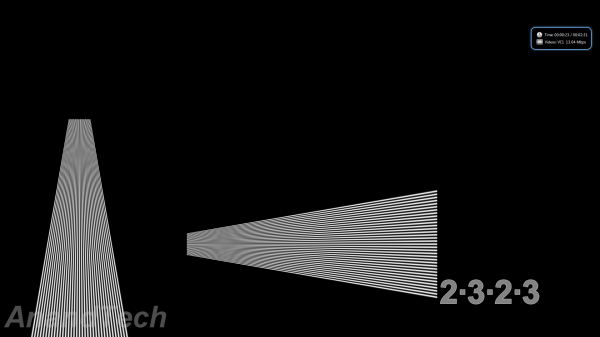ASRock's High-End Vision 3D 252B HTPC Review
by Ganesh T S on May 7, 2012 6:15 AM EST- Posted in
- Home Theater
- Sandy Bridge
- HTPC
- GT 540M
- NVIDIA
HQV scores are meant to be a quantitative metric, but some of the aspects deserve further coverage. In earlier reviews, we had provided screenshots of the Cheese Slices test in order to show deinterlacing performance, and in the Llano review, we looked at issues with the chroma upsampling algorithm. In this section, we will see how the GT 540M fares.
Cadence Detection:
The GT 540M obtains the maximum possible score for cadence detection in the HQV benchmarks. But, is it really effective in all cases? We took the Spears & Munsil Wedge Pattern clip for a test drive. The same test clip was used in our Discrete HTPC GPU Shootout piece. In the previous test, only the GT 430 was able to perfectly inverse telecine the clip. The GT 540M managed to retain that ability.
However, some of the other cadences (including those for which the HQV clips were processed correctly) were not properly inverse telecined / deinterlaced. The gallery below provides information on the troublesome patterns.
In addition, videos often have overlaid text which might be of a different cadence. The 'shredded text' resulting from the video processor being unable to do local cadence decisions often ruins the experience. Some GPUs (like Intel's HD Graphics 3000 in the ASRock CoreHT 252B) take more time to lock onto the cadence compared to others (such as those from AMD). Unfortunately, the GT 540M belongs to the former category. It has problems with both horizontal and vertical scrolling text for more than 5 - 10 frames before locking onto the local cadence.
Deinterlacing:
Instead of the Cheese Slices clip, we have a new deinterlacing testclip (a 480i MPEG-2 stream that we first used in the Zotac ZBOX Nano XS review). As expected, the Vision 3D 252B had no trouble deinterlacing this stream. Further down in this review, we also have rendering benchmarks which show how much the IVTC (inverse telecine / cadence detection / film mode detection) and deinterlacing operations load up the GPU.
We also processed the boat clip from the Spears & Munsil disc, and to tell the truth, there is not really much difference in the quality of deinterlacing that we see between AMD, NVIDIA and Intel. All that matters is whether the GPU is powerful enough to deinterlace content at a given frame rate and resolution, and suffice to say that the GT 540M has no problems even with deinterlacing 1080i60 content (as we will see in a later section).
Chroma Upsampling:
The HQV CUE / ICP testclip was used to check up on the chroma upsampling quality of the drivers. In the gallery below, you will find three screenshots taken in the course of playback (one with PowerDVD, one with ArcSoft TMT and the other madVR set to Softcubic (Softness 70) chroma scaling. Though one can say that the madVR output holds the slight edge, it looks like the algorithm used in the NVIDIA drivers is no slouch
Noise Reduction:
The gallery below presents the noise reduction algorithms in action. Noise reduction strength can be set between 0 and 100, and the gallery below has screenshots for 0, 50 and 100 noise reduction settings for each segment of the clip. The noise reduction algorithms work decently, but the difference is not as stark as, say, what one gets with the AMD GPUs when mosquito noise reduction is enabled.
Contrast Enhancement and Skin Tone Correction:
Simply put, the dynamic contrast enhancement and skin tone correction options in the NVIDIA Control Panel do not work. The gallery below presents the necessary proof.
The color tab in the panel has a contrast setting, but that affects the picture as a whole and doesn't work in the manner that the HQV benchmark guide expects it to. Color enhancement is supposed to take care of skin tone correction, but that was quite ineffective too. We remember seeing the dynamic contrast feature working in a previous driver version, and this just goes to prove that NVIDIA is as guilty of breaking HTPC features in their drivers as AMD is. That said, the driver version v301.24 we tested with is not WHQL certified (I had to move up from v296 because there were some graphics driver stability issues in my setup while testing various HTPC aspects). So, we are willing to cut NVIDIA some slack. However, we hope that NVIDIA is aware of this issue and will take steps to correct it based upon user feedback.






























60 Comments
View All Comments
BPB - Monday, May 7, 2012 - link
Hook this up with an HDHomeRun Prime and you have one heck of a DVR. It will do lots more than any of the other items you mentioned.But, the point about the Mac Mini is a good one, you can just buy one of those, load Windows for $100, and you're good to go (sans blu-ray).
Southernsharky - Monday, May 7, 2012 - link
http://www.newegg.com/Product/Product.aspx?Item=N8...HP Pavilion dv6-6c50us Notebook Intel Core i5 2450M(2.50GHz) 15.6" 6GB Memory DDR3 750GB HDD 5400rpm BD Combo Intel HD Graphics 3000
In stock.
Was: $799.99
Now: $759.99
Ok yes it only has 6gb of memory, but it also has a quad core processor... and of course a screen and that sort of thing.... And oh yeah... its 759.99.
Its even got the 750gb HD.......
ganeshts - Monday, May 7, 2012 - link
That would compare with the Core HT 252B we reviewed earlier (There is no dGPU in that model).Add the dGPU, and the laptop cost would turn out to be similar to that of the system here. The only difference is the screen (we have analyzed this in the first generation Vision 3D review), and the reason the laptop turns out cheaper is because of the economies of scale (more laptops are bound to be sold compared to the number of such HTPCs).
Wurmer - Monday, May 7, 2012 - link
I agree with many posters here, 1190.00 $ for an HTCP is way too much money. I've built a few by mostly salvaging parts from older computers. Some may argue that I don't get the best power efficiency by doing is so but I certainly save a bundle of cash in parts. Anyways, you don't need a super powerful rig to play Blue ray and store media. A good mid end rig of three years ago is plenty good for HTCP usage. I got some parts on the cheap so my next HTPC will include an AMD x3 455, 8 gig of rams and cheap MSI board, GT 430. The only thing I'll be spending cash on this time around is a dedicated HTPC case from Lian Li (200.00$) which should last me many years. The only real thing that is expensive with that kind of built is the storage since the last year or so HHD prices have gone through the roof and if you use you HTPC quite a bit then you need some serious storage space.philipma1957 - Monday, May 7, 2012 - link
Yeah I agree I even set about building a htpc/gamer with new parts.an intel 2500t 210 or a 2500k for 210 I have both.
a crucial ssd 199
a wd 2tb hdd 99
a passive gpu card hd7750 140 or a hd6870 with a fan for 150 I have both,
a mobo 130
samsung ram 80
a cheap rosewill case 25
a seasonic psu 110
a samsung bluray 65
total 1058
add soft ware and a tuner and you are at 1.2k all new parts. functionally it is just better.
It will game that gpu gets 7.4 on wei and if you sub a hd6870 you can game at almost all games. I know I have a hd6870 and it runs hotter uses more power but gamers better and gets a 7.8 for wei.
now if you are in an apartment and are really tight for space this unit makes sense over my build.
If you have rack space this unit does not make sense at least to me it doesn't. my wei scores are 7.3 for the cpu and 7.4 for the gpu. and 7.8 for all other. if you swap the 2500k and the hd6870 you get 7.8 for all score . same price but more watts used. this all fits in a 14 by 14 by 7 inch case.
I can't see using the asrock unless space is really really really tight.
Scannall - Monday, May 7, 2012 - link
A Mac Mini with an i7 and a real video card is $4.00 less. And a better machine.Wurmer - Monday, May 7, 2012 - link
I've considered the mac mini but the IGP Intel 3000 is a bit weak and the one with the optional AMD GPU is not much more powerful. When the Mac mini gets Ivy bridge and Intel 4000 IGP things will be more interesting I think.justniz - Tuesday, May 8, 2012 - link
This unit comes with an IR receiver.Why are most manufacturers still producing/supporting IR remotes instead of wireless remotes?
Wireless remotes have many advantages and no disadvantages, such as better range, including through walls, they still work in bright sunlight, and theres no need to point the remote at the receiver.
The ergonomics of remotes is limited by the need to point them. Without that limitation their whole design could be improved.
JSt0rm01 - Tuesday, May 8, 2012 - link
for $99 you can get a apple tv that while it has way less raw "features" Has the ability to stream content from your main system and stream from the internet all in 1080p with 5.1 digital audio output. I dont see how these feature sets are worth $900 more then the feature set of a apple tv or roku.---------------------------------
Also, after being a member of the anandtech forums for 10 years I was permanently banned by the moderators there because they wanted to censor a website (ffdt.info) that had conversation that was critical of their moderation. I find that the free flow of all information on the internet is critical. For a tech website such as this to limit the flow of information is offensive the core of these beliefs and its all because certain people in positions of illusory power deem that information detrimental to their positions.
axellslade - Tuesday, May 8, 2012 - link
I just built a brand new HTPC but I can't seem to be able to find the VESA mounting holes on the side of my HAF X. And it's weighting like a ton. I think I did something wrong.